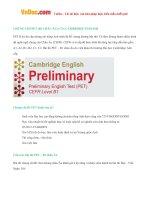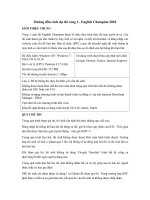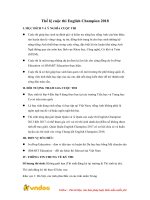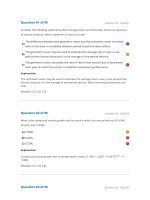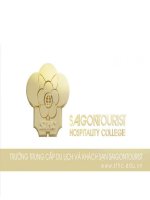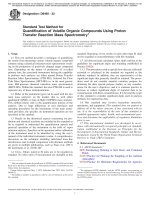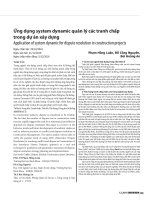ANTONYMY AND ITS IMPLICATIONS FOR TEACHING ENGLISH
Bạn đang xem bản rút gọn của tài liệu. Xem và tải ngay bản đầy đủ của tài liệu tại đây (90.95 KB, 15 trang )
Vietnam National University, Hanoi
University of Languages and International Studies
Post-graduate Department
Semantics
(Final assignment)
ANTONYMY AND ITS IMPLICATIONS FOR
TEACHING ENGLISH
Student
School year
Lecturer
Deadline
Hanoi – 2010
: Nguyễn Thị Tâm
: 2009 – 2010
: Dr. Hà Cẩm Tâm
: 28th June 2010
Antonymy and its implications for teaching English
Nguyễn Thị Tâm–K18C
TABLE OF CONTENTS
Chapter 1: Introduction ………………………….………………………...1
1.1. Rationale of the study ..........................................................................................1
1.2. Research questions...............................................................................................1
1.3. Scope of the study ...............................................................................................1
1.4. Significance of the study .....................................................................................1
1.5. Methods of the study ...........................................................................................2
Chapter 2: Development
2.1. Definitions of antonymy……………………………..…………………………3
2.2. Characteristics of antonyms…………………………..…………...……………4
2.3. Types of antonyms …………………………………..…………………………5
2.3.1. Conventional classification ………………..…………….……………5
2.3.2. John Lyon’s classification ……………………..….………………….6
2.3.3. Other types …………………………………..………………………..7
2.4. Implications for teaching English ……………………..……………………….8
2.4.1. For teaching vocabulary……………………………………………….8
2.4.2. For teaching writing………………………...…………………………9
Chapter 3: Conclusion ………………………………………..…………...11
References ………………………...……………………………..…………12
2
Antonymy and its implications for teaching English
Nguyễn Thị Tâm–K18C
Chapter 1: Introduction
1.1.
Rationale of the study
Antonymy is one of the basic structural relations in the vocabularies of any
human language. The existence of a large number of antonyms in the vocabulary of
a language would seem to be related to a general human tendency to polarize
experience and judgment – to think in opposites. Yet in most discussion of word
meaning the concept has been curiously neglected, although much attention has
been given to other semantic relations, such as synonymy.
A study on antonymy with its implications for language teaching is needed.
Therefore, in this research, I would like to explore that slighted dimension of the
most important semantic relation.
1.2. Research questions
This study addresses four research questions:
What is antonymy?
What are the characteristics of antonyms?
What are types of antonyms?
What are implications for teaching English?
1.3. Scope of the study
In the scope of a final assignment, I do not have an ambition to cover all
sense relations I have studied in the course. I only focus on antonymy and give some
suggestions on how it can be used in teaching English.
3
Antonymy and its implications for teaching English
Nguyễn Thị Tâm–K18C
1.4. Significance of the study
This study, to some extent, will help the readers understand one of the most
important types of sense relations - antonymy and antonyms clearly. Moreover, it
can provide teachers of English with some suggestions on teaching vocabulary and
writing through antonymy. It is hoped that this study will be a good food for
thoughts for the teachers and a useful reference material for the further study on the
related subjects.
1.5. Methods of the study
To complete this study, I have carried out a lot of reading and consulting.
Firstly, information relating to antonymy is collected from books borrowed from the
library, and from some articles available on the Internet. The combination of
information obtained from reading materials and consultation can help me to draw
out the outline of this study.
4
Antonymy and its implications for teaching English
Nguyễn Thị Tâm–K18C
Chapter 2: Development
2.1. Definitions of antonymy
Antonymy has been defined by many different linguists and semanticist;
however, in general, these definitions are the same in essence. According to
wordreference.com dictionary, antonymy is a semantic relation that holds between
two words that can (in a given context) express opposite meanings. In general, it is
concerned with semantic opposition.
These follows are some definitions of antonyms which I find the most
comprehensible ones. Arnold (1986:209) states that “antonyms may be defined as
two or more words of the same language belonging to the same part of speech and to
the same semantic, identical in style and nearly identical in distribution, associated
and often used together so that their denotative meaning render contradictory or
contrary notions.”
Antrushina G.B. (1985:167) also points out that “we use the term antonyms
to indicate - words of the same parts of speech which have contrasting meanings.”
In general, antonymy is not evenly distributed among the categories of parts
of speech. Many words, especially those denoting concrete objects (chair, tree, and
tiger) have no antonyms. Usually, adjectives denoting qualities, verbs denoting
actions or states and abstract nouns have antonyms. Most antonyms are adjectives
5
Antonymy and its implications for teaching English
Nguyễn Thị Tâm–K18C
which are not only natural because qualitative characteristics are easily compared
and contrasted such as high - low, wide - narrow, strong - weak, old - young,
friendly - hostile. Verbs take the second place after adjectives, so far as antonymy is
concerned. Here are some of them: to lose - to find, to live - to die, to open - to
close. Nouns are not rich in antonyms, but even so some examples can be given: joy
- grief, heaven - earth. Antonymic adverbs can be subdivided into two groups: (a)
adverbs derived from adjectives: warmly - coldly, merrily - sadly, and (b) adverbs
proper: now - then, here - there, ever - never, up - down, in - out. It should be noted
here that polysemic words may have different antonyms for different meanings.
E.g.
A dull pupil – a bright pupil
A dull book – an interesting book
A dull knife – a sharp knife
Dull color – bright color
Many words though having synonyms do not find their semantic opposites. For
example, these are “read, hit, house, book, power, magazine”. That’s the reason why
there are a great many more synonyms than antonyms in a language.
2.2. Characteristics of antonyms
In this study, I would like to list 4 characteristics of antonyms as follows:
Belong to the same semantic field, nearly identical in distribution.
E.g. big- small (adjectives about size)
Do not differ either in style or emotional coloring.
E.g. Is she slender/ slim/ thin/ fat?
In many pairs of antonyms, one is marked and the other is unmarked. The
unmarked member is also the global member of the opposition. For example,
6
Antonymy and its implications for teaching English
Nguyễn Thị Tâm–K18C
in pair “old and young”, “old” is global, unmarked adjective. It is used with
units of time to express age. When we say “the baby is four days old”, we are
not saying that the baby is old, and in saying “the box is three inches deep”,
we are not saying that “the box is deep”.
Gradable terms differing in degree of intensity each has its own
corresponding antonyms.
E.g. cold – hot; cool – warm
2.3. Types of antonyms
2.3.1. Conventional classification
Antonyms are conventionally classified into 2 types: root word antonyms
(antonyms proper) and derivational antonyms.
Root word antonyms are words that are of different forms and of opposite
meanings.
E.g.
old – young; kind – cruel
Derivational antonyms are words of the same root, one of which having a
negative affix (according to Arnold (1986: 213)). The affix in them serves to
deny the quality stated in the term. It is not difficult to find examples where
contrast is implied in the morphological structure of the word itself.
E.g.
appear – disappear; pleasant – unpleasant
logical – illogical; regular – irregular;
useful – useless; normal – abnormal
7
Antonymy and its implications for teaching English
Nguyễn Thị Tâm–K18C
There are typical affixes and typical patterns that go into play in forming
these derivational antonyms. It is significant that in the examples given above
prefixes prevail. The regular type of derivational antonyms contains negative
prefixes: dis-, il-, im-, ir-, mis-, non- and un-. Other negative prefixes occur
in this function only occasionally.
As to the suffixes, it should be noted that modern English gives no examples
of words forming their antonyms by adding a negative suffix, such as, for
instance, less. The opposition “hopeless – hopeful”, or “useless – useful” is
more complicated, as the suffix -less is not merely added to the contrasting
stem, but substituted for the suffix -ful. The group is not numerous. In most
cases, even when the language possesses words with the suffix -less, the
antonymic pairs found in actual speech are formed with prefix un-. Thus, the
antonymic opposition is not selfish - selfless but selfish - unselfish.
In general, several features distinguish the two groups of antonyms. In words
containing one of the above negative prefixes, the contrast expressed
morphologically as the prefixed variant is in opposition to the un-prefixed one.
Therefore, if the morphological motivation is clear, there is no necessity in contexts
containing both members to prove the existence of derivational antonyms. The word
unsuccessful, for instance, presupposes the existence of the word unsuccessful, so
that the following quotation is sufficient for establishing the contrast. Essex was
always in a state of temper after one of these unsuccessful interviews.
The patterns, however, although typical, are not universal, so that
morphologically similar formations may show different semantic relationships.
Disappoint, for example, is not the antonym of appoint, neither is unman to deprive
of human qualities’ antonyms of man to furnish with personnel.
2.3.2. John Lyon’s classification
8
Antonymy and its implications for teaching English
Nguyễn Thị Tâm–K18C
John Lyons divided antonyms into 2 types: antonyms proper and
complementary antonyms.
Antonyms proper are easily gradable, and represent contrary notions.
E.g:
hot – warm – cool – cold
ugly – pretty
It is interesting to note that such words as young - old, big - small, good - bad
do not refer to independent absolute qualities but to some implicit norm, they
are relative. The semantic polarity in antonym proper is relative, the
opposition is gradual, and it may embrace several elements characterized by
different degrees of the same property. The comparison they imply is clear
from the context. This relation is typically associated with adjectives and has
two major identifying characteristics:
-
Firstly, there are often intermediate terms so that between the gradable
“hot” and “cold” we can find “hot (warm/ tepid/ cool) cold”.
-
Secondly, the terms are usually relative. So a thick pencil is likely to be
thinner than a thin girl.
-
Thirdly, with gradable pairs, the negative word of one member of the pair
is not synonymous with the other. For instance, “unhappy” doesn’t
necessarily mean “sad”.
-
Lastly, it is true of gradable antonyms that more of one is less of the other.
For example, “more happy” means “less sadness”.
Complementary antonyms (binary antonyms) involve two items and
presuppose that the assertion of one is the negation of the other. If one of the
pair is true, then the other cannot be true. They are mutually exclusive and
admit no possibility between them. They are non-gradable.
9
Antonymy and its implications for teaching English
Nguyễn Thị Tâm–K18C
E.g. Male – female; dead – alive
Present – absent; boy – girl
Same – different
2.3.3. Other types
Converses (relational opposites): denote one and the same situation viewed
from different points of view with a reversal of the order of participants and
their roles; display symmetry in their meaning.
E.g. Buy – sell; give – tale; parent – child; left – right; lock – unlock
The relation is closely connected with grammar, namely with grammatical
contrast of active and passive. The substitution of a conversive does not
change the meaning of a sentence if it is combined with appropriate regular
morphological and syntactical changes and selection of appropriate
prepositions. He gave her flowers. She received flowers from him = She was
given flowers by him.
Some linguists classify conversives as a subset of antonyms; others suggest
that antonyms and conversives together constitute the class of contrastives.
Although there is parallelism between the two relations, it seems more logical
to stress that they must be distinguished, even if the difference is not always
clear- cut. The same pair of words e.g. fathers and sons may be functioning as
antonyms or as conversives.
Directional antonyms (reverses): The characteristic reverse relation is
between terms describing movement, where one term describes movement in
one direction, and the other the same movement in the opposite direction, for
example the terms “push and pull on a swing door”, which tell you in which
direction to apply force. Other such pairs are come/go, go/return, and
ascend/descend. When describing motion the following can be called
10
Antonymy and its implications for teaching English
Nguyễn Thị Tâm–K18C
reverses: (go) up/down, (go) in/out, (turn) right/left. By extension, the term is
also applied to any process which can be reversed: so other reverses are
inflate/ deflate, expand/contrast, full/empty.
2.4. Implications for teaching English
2.4.1. For teaching vocabulary
It can be denied that teaching vocabulary plays an important role in second or
foreign language teaching. “Without grammar very little can be conveyed; without
vocabulary nothing can be conveyed.” (Wilkins, 1972:111). “The more one
considers the matter, the more reasonable it seems to suppose that lexis is where we
need to start from, the syntax needs to be put to the service of words and not the
other way round.” (according to Widdowsen in Lewis, 1993:115)
Many researchers and practitioners have seen the relationship between
antonyms and teaching vocabulary. Teaching antonyms strengthens a learner’s
concept of words and develops her vocabulary. Therefore, it’s advisable for teachers
to teach related words together so that students will remember the new words easily
for a longer period of time. While teaching reading lessons, the teachers can
occasionally stop and point out a particular word and ask the students to think of a
word that has an opposite meaning. This will help them learn both of words at the
same time and in a simple but effective way. Not all words have antonyms, but
thinking about for those that do, opposite requires students to evaluate the critical
attributes of the words in question.
To revise and review vocabulary, teachers also can create many kinds of
exercises and activities basing on antonymy such as matching or fill-in-opposites
activities in a motivating way in order for students to commit them to their memory.
As an example, teachers divide the class into 2 groups: A and B. Next, he/she reads
aloud words one by one and each group takes turn giving their antonyms of these
11
Antonymy and its implications for teaching English
Nguyễn Thị Tâm–K18C
words. Each right antonym will equal to 2 points. Two groups will compete with
each other to find the winner.
Besides, teachers can organize some funny and interesting games using
antonymy to teach their students vocabulary such as crossword game and word
uncramble. She can divide the class into smaller groups of 4 or 5 members. Each
group will receive a paper containing many letters which can be combined with each
other horizontally, vertically or diagonally into antonyms. The group which can find
all right antonyms in the shortest time is the winner.
Such activities and techniques require students to think of new words or
recall the vocabulary they have learned. Brainstorming and using antonyms are great
ways to increase their vocabulary and expose them to different words that are above
their grade level.
2.4.2. For teaching writing
It is necessary for students to acquire a flexible way of expressing and
supporting their ideas. In teaching writing, teachers should raise their students’
awareness of using different words or expressions to avoid repeating and to make
their writing more compelling. She/he needs to remind them to think up antonyms
when they write because they can always use a “negative sentence” with an antonym
to express the same, or a similar idea.
For example:
Peter did not accept my invitation = Peter refuse my invitation
As another illustration, if students are looking to express a relationship between the
quality of parenting and the education of the child, they could write either something
like:
“With good care, his parents gave him such a headstart. In life, learning in school
was so easy for him, teachers assumed he was smart.”
12
Antonymy and its implications for teaching English
Nguyễn Thị Tâm–K18C
Or “In the later grades of the child, you could see the effect of a great many early
years of parental neglect.”
Or they might use both.
Chapter 3: Conclusion
In conclusion, it should be emphasized again that antonymy is one of the
most important sense relations which are undeniably a part of semantics and can be
viewed as the central part to concentrate on by some semanticists. Mastering
13
Antonymy and its implications for teaching English
Nguyễn Thị Tâm–K18C
antonymy and other types of sense relations should be a “must” for those who would
like to get insight to find out how interesting a language is. Of equal importance, for
practitioners and teachers of English, teaching antonyms positively contributes to
teaching English in general and teaching vocabulary and writing in particular. It is
necessary for them to apply their knowledge of antonymy into their teaching
effectively.
REFERENCES
14
Antonymy and its implications for teaching English
Nguyễn Thị Tâm–K18C
1. Antrushina G.B. (1985). English lexicology.
2. Arnold I.V. (1986). The English Word.
3. />4. Nguyen Hoa. (2000). Understanding English Semantics. VNU Hanoi Press.
Hanoi.
5. Teaching Vocabulary. (n.d.). retrieved from
/>6. Vo Dai Quang. (2006). Semantics. Nxb van hoa thong tin. Hanoi.
15

